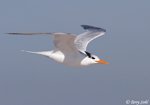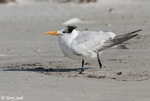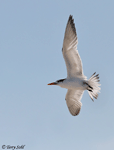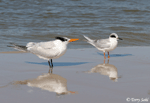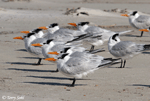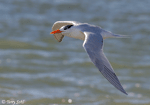| Length: 20 inches | Wingspan: 40 inches | Seasonality: Non-resident in South Dakota |
| ID Keys: Light gray above, white below. Adults have dark legs, orange-red bill, black cap (breeding), black-band behind eye (non-breeding) | ||
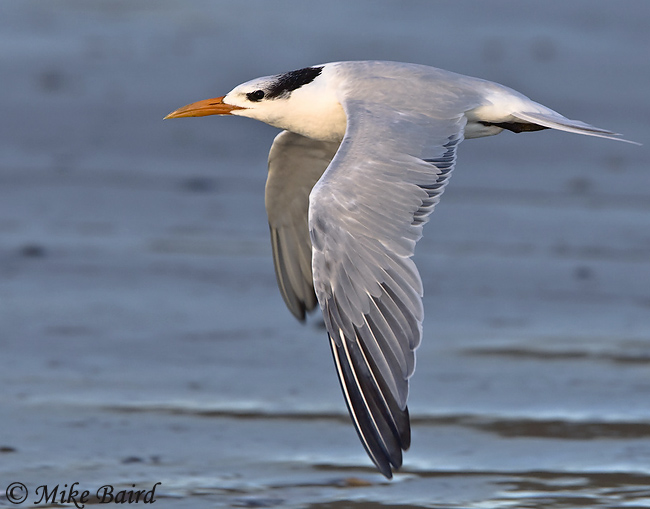 The
Royal Tern is a relatively common seabird with a distribution in both North
and South America. In North America, they are primarily found in and
around the warmer coastal waters of the Gulf Coast and Atlantic Coast,
although in winter, non-breeding birds are distributed much more widely,
including along the California coast. They are similar in appearance
to the Caspian Tern, but are more
lightly built and with a thinner and lighter-colored bill.
The
Royal Tern is a relatively common seabird with a distribution in both North
and South America. In North America, they are primarily found in and
around the warmer coastal waters of the Gulf Coast and Atlantic Coast,
although in winter, non-breeding birds are distributed much more widely,
including along the California coast. They are similar in appearance
to the Caspian Tern, but are more
lightly built and with a thinner and lighter-colored bill.
Habitat: During the summer breeding season, they are most often found on sandy beaches on islands or elsewhere on the coast. Non-breeding birds are found on coastlines with warmer waters, although they can sometimes be found far from shore.
Diet: Feeds on fish, crustaceans, squid, and shrimp.
Behavior: Foraging is typically done by flying over the water's surface and plunging down into the water to capture prey when spotted. They will also sometimes capture prey by skimming the water's surface in flight.
Nesting: Royal Terns nest in colonies, sometimes in very high densities. The nest is a shallow scrape in the sand, sometimes with a lining of bits of vegetation or other debris. The female usually lays just one egg, and both parents help to incubate it. Upon hatching, both parents take care of the young and help feed it. Juvenile birds often remain with their parents for 6 months or more.
Song: Primary call is a loud, hoarse rolling call, with a variety of other vocalizations.
Migration: In North America, can be found at all times of the year around breeding habitats in the Caribbean, Gulf Coast, and locally on the Atlantic Coast. Birds in the northern part of the breeding range do tend to move further south for the winter. Non-breeding birds are dispersed widely along the Gulf and Atlantic coasts, and are found on the California coast as well in winter.
Interactive eBird Map: Click here to access an interactive eBird map of Royal Tern sightings
Similar Species: Caspian Tern, Elegant Tern,
Conservation Status: Populations of the Royal Tern are large, widely distributed, and appear to be stable. The IUCN lists the Royal Tern as a species of "Least Concern".
Further Information: 1) Audubon Guide - Royal Tern
2) USGS Bird Identification InfoCenter - Royal Tern
3) Florida Fish and Wildlife Commission - Royal Tern
Photo Information: Photo taken by Mike Baird - February 2008 - Morro Bay, California - Photo licensed under Creative Commons Attribution 2.0 Generic License.
| Click below for a higher-resolution map |
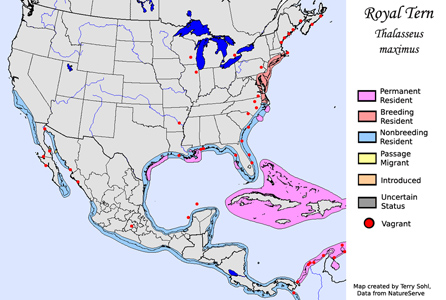 |
| South Dakota Status: Non-resident in South Dakota |
Additional Royal Tern Photos
Click for a higher-resolution version of these photos
